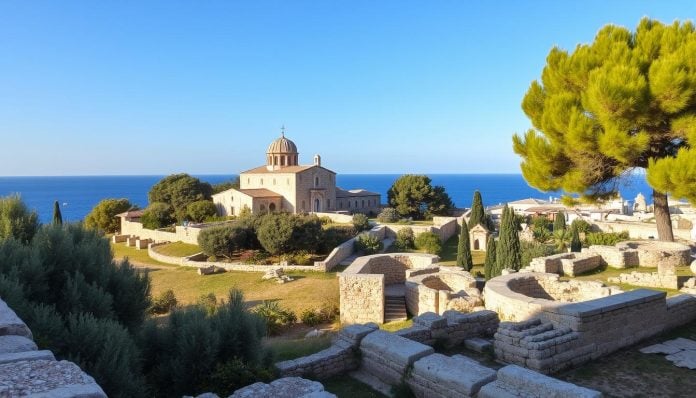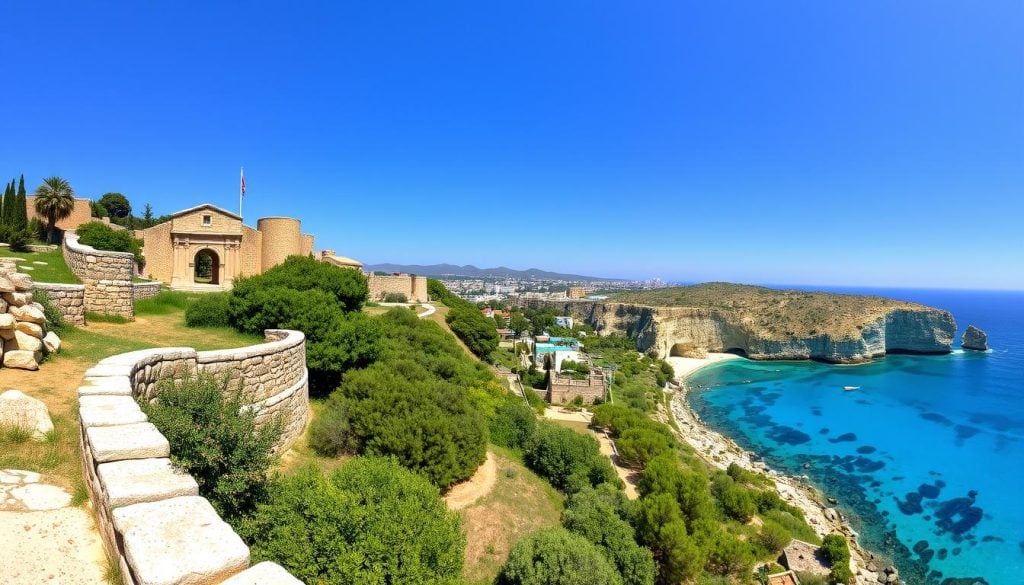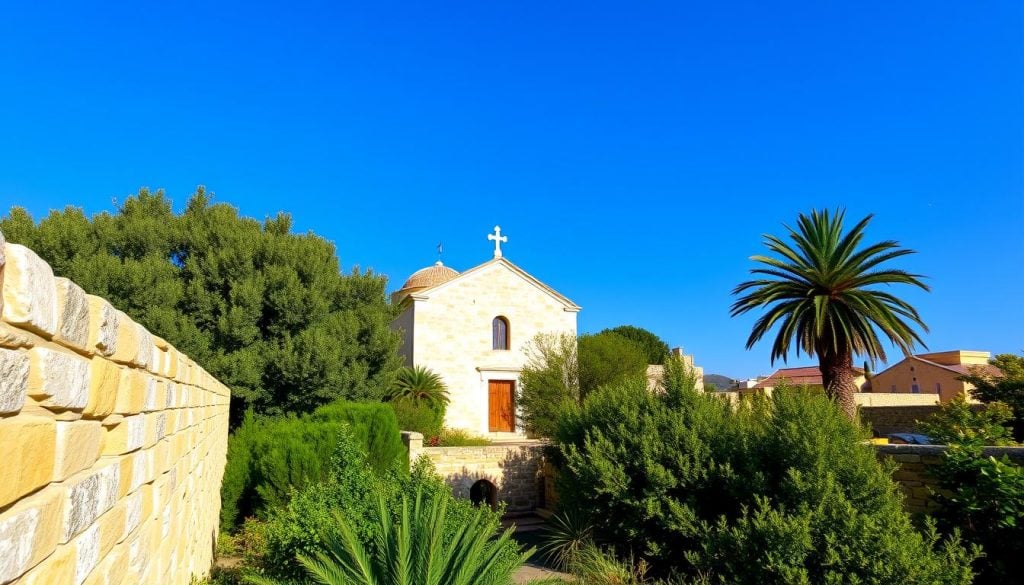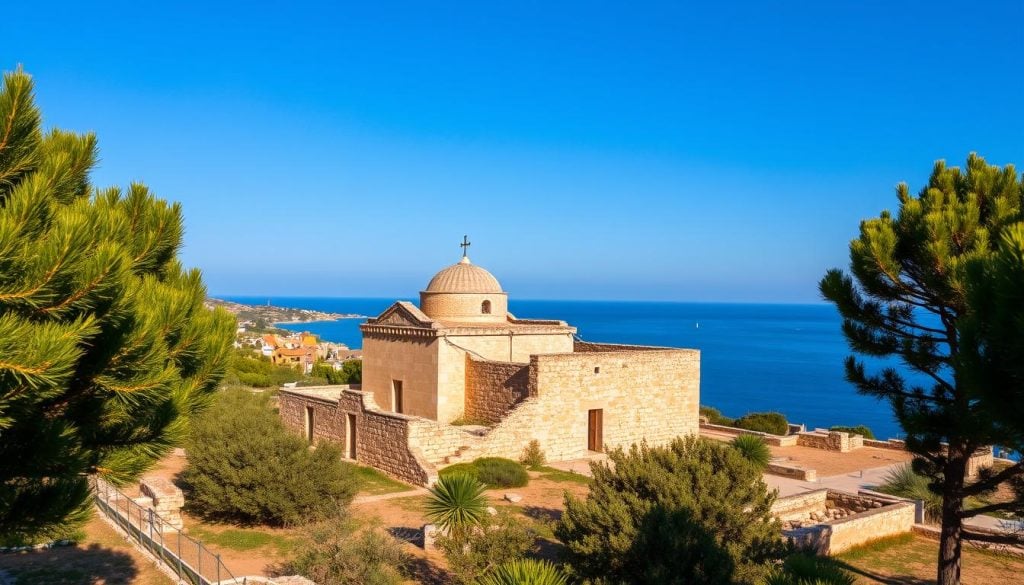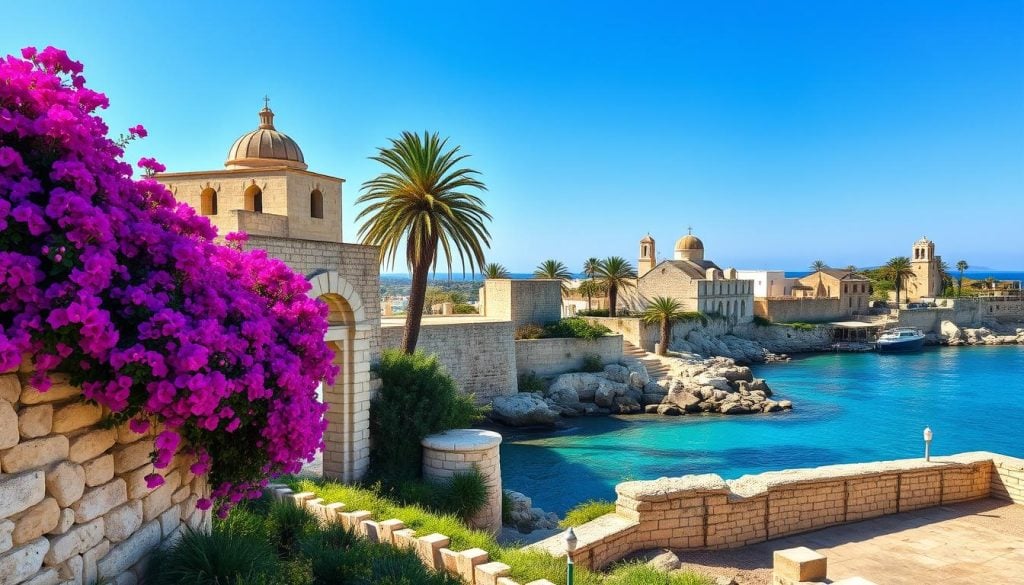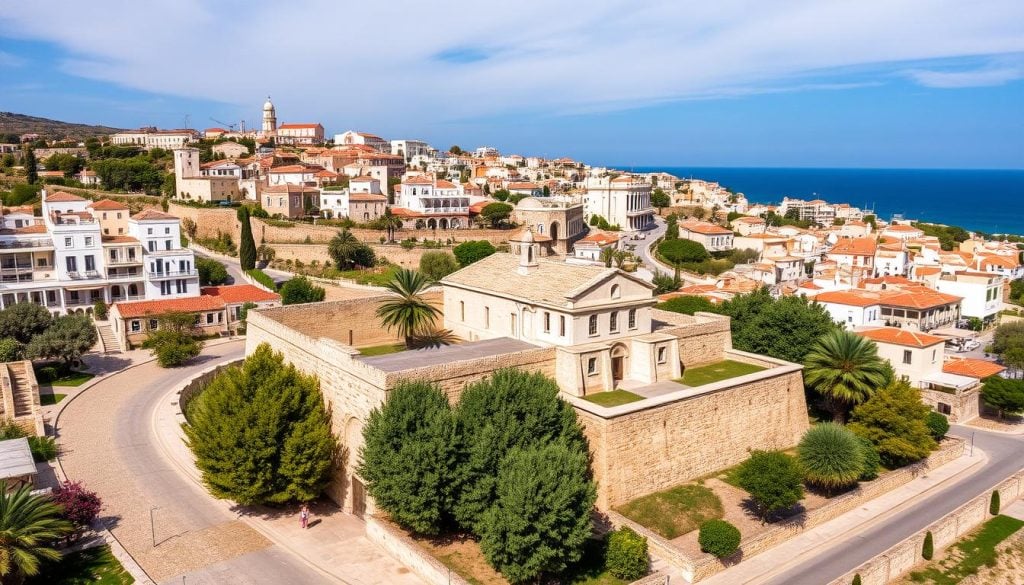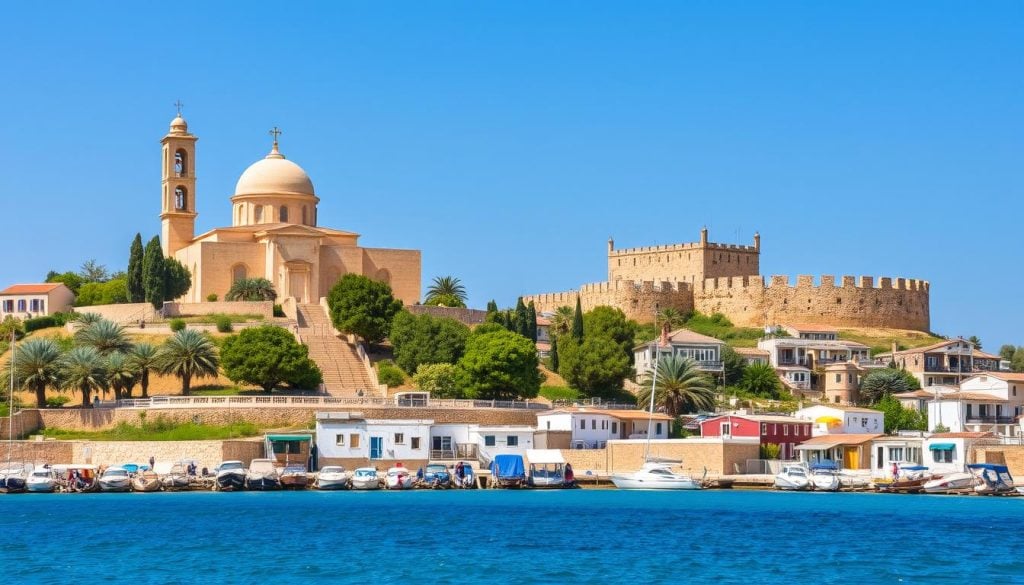Have you ever wondered about the stories hidden beneath Ayia Napa’s lively nightlife and beautiful beaches? This town on Cyprus’s southeastern coast is more than just a party spot. It has a deep history that goes back centuries.
The name “Ayia Napa” means “Holy Forest” in Greek. This shows its connection to a 14th-century Venetian monastery at its heart. In this journey, you’ll find the top historical sites in Ayia Napa. From ancient ruins to cultural treasures, you’ll see why Ayia Napa’s landmarks are a must-see.
Introduction to Ayia Napa’s Rich History
Ayia Napa started as a small fishing village on Cyprus’s southeastern coast. Over time, it grew into a lively tourist spot. By the 1970s, more visitors came, bringing new life and businesses.
This transformation shows how Ayia Napa’s past has shaped its lively present. Exploring its history lets you see the roots of its vibrant atmosphere.
Knowing Ayia Napa’s history makes your visit even more special. There are many historical sites to see, each with its own story. These sites show the area’s rich past and cultural impact.
As you explore, you’ll gain a deeper understanding of Ayia Napa’s journey. It’s a journey from a small village to a bustling tourist area. This knowledge adds to your appreciation of its history and importance today.
The Significance of the Ayia Napa Monastery
The Ayia Napa Monastery is a key part of the area’s history and culture. Built in the 14th century, it was crucial for Ayia Napa’s early growth. Its mix of Gothic and Byzantine styles makes it a standout historical site.
History and Architecture of the Monastery
The monastery’s story is fascinating. It was built around a cave with an icon of the Virgin Mary. The stone carvings and arched windows show the skill of its builders.
Walking through, you’ll find peaceful courtyards and gardens. These add to the monastery’s beauty. It’s more than just a building; it’s a symbol of Ayia Napa’s spiritual and cultural past.
Visiting Tips and Opening Hours
Visitors can enjoy the monastery’s calm any day. It’s a good idea to check the hours before you go. Admission is usually free, making it easy to explore.
When you visit, dress respectfully. This way, your time at this special place will be both memorable and meaningful.
What Historical Sites Can I Visit in Ayia Napa?
Exploring Ayia Napa historical tours reveals a wealth of sites. This lively town boasts both old churches and new monuments. Each tells a story of the past. Highlights include the Ayia Napa Monastery with its beautiful architecture and peaceful gardens. There are also smaller chapels all over the area.
Visiting Ayia Napa cultural heritage sites lets you uncover fascinating histories. The Monastery of St. George is a standout, offering visitors a chance to see its importance. Ayia Napa’s mix of old and new culture gives a special view of its growth.
- Ayia Napa Monastery
- St. George Chapel
- Sea Caves
- The Cultural Centre
- Ancient Tombs of Makronissos
Every spot offers a glimpse into Ayia Napa’s rich history. It makes for a rewarding visit for all who come.
| Site Name | Description | Notable Features |
|---|---|---|
| Ayia Napa Monastery | A historic monastery dating back to the 14th century. | Beautiful architecture, tranquil courtyard. |
| St. George Chapel | A small yet charming chapel known for its serene atmosphere. | Unique frescoes and scenic views. |
| Ancient Tombs of Makronissos | A burial site from the Hellenistic period. | Caves and tombs carved into the rock. |
Ancient Ruins Near Ayia Napa
Exploring Ayia Napa reveals the ancient ruins nearby. The Ruins of Salamis and Kition are key sites. They show Cyprus’s rich history and offer a deep experience for visitors. Here’s what awaits at these top historical spots in Ayia Napa.
The Ruins of Salamis
Salamis, close to Ayia Napa, boasts well-preserved ruins. You’ll see a stunning theater and a gymnasium, telling stories of Cyprus’s Roman times. Walking through, you can almost hear the sounds of old performances and sports.
Archaeological Insights at Kition
Kition is another major archaeological site, famous for its ancient temples and pottery. Educational tours here shed light on the ancient Cypriot civilization. It’s a must-see for its historical and cultural value.
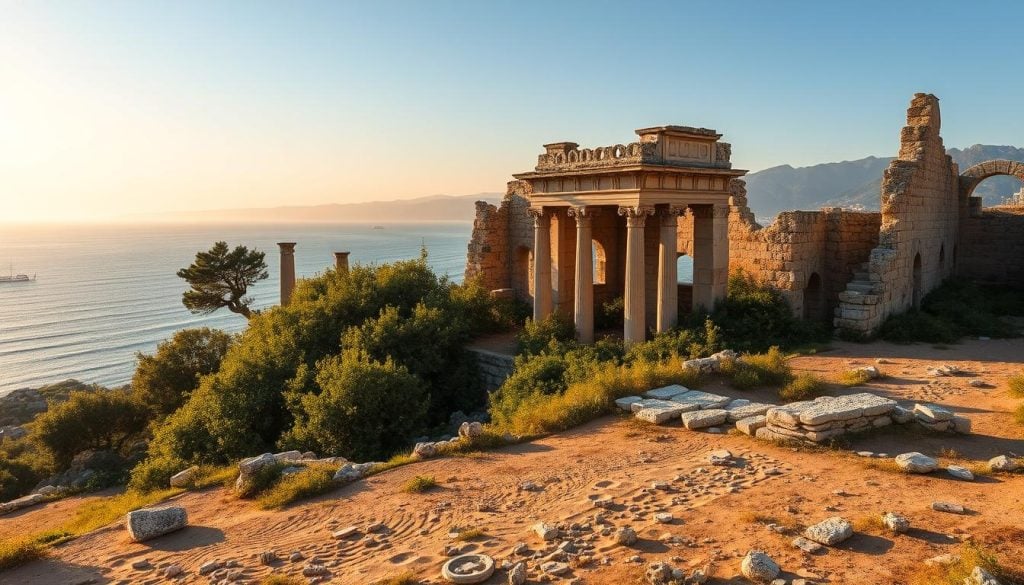
Exploring Ayia Napa’s Cultural Heritage Sites
Ayia Napa is full of cultural sites that show its rich history. You can find local museums that share insights into Cypriot life, arts, and crafts. These places display both new and old exhibits, giving a peek into the island’s artistic journey.
Art galleries in Ayia Napa are great for meeting local artists and seeing their work. From paintings to sculptures, each piece has a story connected to the island. Visiting these galleries lets you see the creative energy in this coastal town.
Throughout the year, Ayia Napa hosts many festivals celebrating its cultural diversity. These events include music, dance, and food, inviting you to dive into local traditions. Joining in these celebrations shows the value of community and heritage, creating lasting memories.
Exploring Ayia Napa’s cultural sites can deepen your understanding of its history. Each visit helps appreciate Ayia Napa’s historical attractions and the need to keep these cultural gems safe.
Ayia Napa’s Historical Attractions: A Tour Guide
Visiting Ayia Napa reveals a treasure trove of historical sites. Ayia Napa historical tours are a great way to explore this heritage. These tours focus on various themes, like ancient ruins and local tales, deepening your understanding.
Popular Guided Tours Available
Guided tours in Ayia Napa offer insightful commentary and access to hard-to-reach spots. You can choose from tours on:
- Ancient Ruins: Visit stunning archaeological sites.
- Folklore and Legends: Discover local stories and traditions.
- Art and Architecture: See the artistic heritage in buildings.
These tours feature guides who share fascinating stories and facts. They make exploring Ayia Napa’s cultural landscape more enjoyable.
Self-Guided Options for History Enthusiasts
For those who like to explore on their own, Ayia Napa has self-guided tours. You can find maps and itineraries to help you visit historical sites at your pace. Highlights include:
- The Ayia Napa Monastery
- The ancient ruins of nearby Kition
- Scenic coastal paths with historical markers
This way, you can take your time and enjoy each site. It lets you explore Ayia Napa history at your own pace.
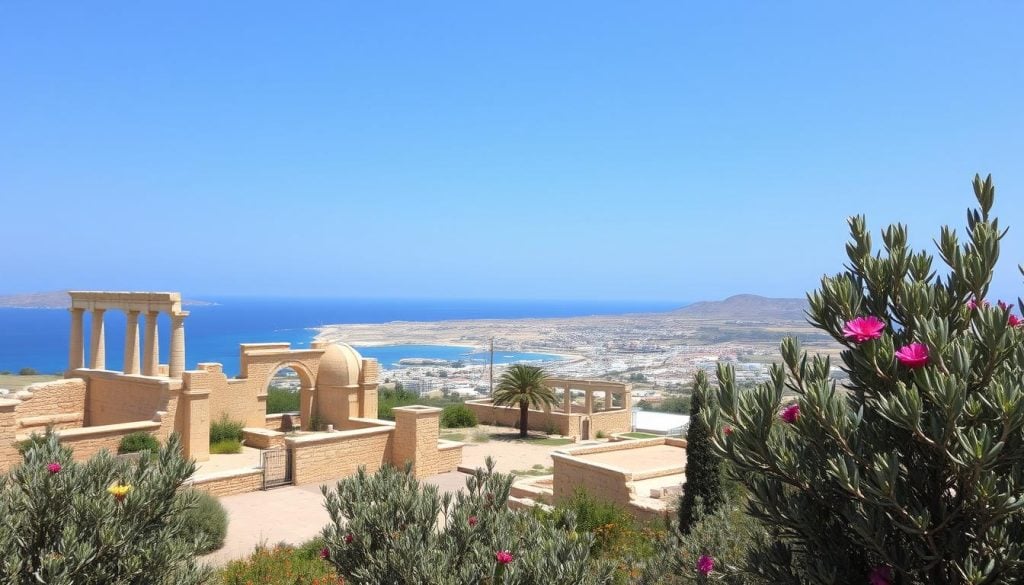
| Tour Type | Description | Duration |
|---|---|---|
| Guided Historical Tour | Expert-led exploration of key historical sites | 3-4 hours |
| Folklore Evening Tour | Discover local myths and stories | 2 hours |
| Self-Guided Historical Walk | Map-led tour of significant landmarks | Flexible |
The Influence of the Venetian Era in Ayia Napa
The Venetian era had a big impact on Ayia Napa’s buildings. As you walk around, you’ll see Venetian walls and homes. These remind us of a time filled with history.
When you visit Ayia Napa, you’ll see how Venetian and local styles mix. Old stone buildings with special features show off the past’s beauty. The walls, built for defense, highlight the town’s strategic importance.
Exploring Ayia Napa’s landmarks shows how these sites helped defend the town. They also shaped its culture. The town’s layout, with narrow streets and squares, is a result of Venetian planning.
For a deeper look at Venetian architecture, take a guided tour. Or, follow self-guided paths to see the past’s charm.
In short, learning about the Venetian era makes Ayia Napa’s history more meaningful. The mix of defense and beauty gives a special view of Cyprus’s past.
Visiting Ayia Napa’s Historical Landmarks
Exploring Ayia Napa’s historical landmarks uncovers the area’s rich past. This coastal town boasts several key sites that shed light on its history. You’ll find everything from the famous Ayia Napa Monastery to the beautiful Ayia Napa Harbor. Each spot has its own story to share.
So, what historical sites can you visit in Ayia Napa? You’ll find a mix of ancient ruins and cultural spots. They are all worth your time.
Iconic Historical Landmarks to See
- Ayia Napa Monastery – A stunning example of 16th-century architecture situated in the heart of the town.
- Ayia Napa Harbor – A picturesque area that reflects the region’s maritime history.
- Ancient Ruins of Salamis – A short distance from Ayia Napa, these ruins offer a glimpse into the ancient world.
- Church of Profitis Elias – Known for its stunning views and historical significance.
What to Expect and How to Prepare
Being well-prepared is key when visiting Ayia Napa’s historical sites. Most are outdoors, so check the weather first. Wear comfortable shoes for walking on uneven paths.
It’s important to respect local customs and etiquette, especially at sacred sites. Knowing this will make your visit more enjoyable and enriching.
Best Historical Sites in Ayia Napa to Discover
Planning a visit to Ayia Napa? Don’t miss its historical attractions. This place is filled with best historical sites in Ayia Napa. Here, you can dive into the local culture and heritage. Below, find a list of top spots to see, with highlights you won’t want to miss.
| Historical Site | Highlights | Suggested Visit Duration |
|---|---|---|
| Ayia Napa Monastery | Impressive architecture and serene gardens | 1-2 hours |
| The Ancient Ruins of Salamis | Vast archaeological remains and ancient theater | 2-3 hours |
| Kition Archaeological Site | Insight into ancient civilizations with preserved ruins | 1-2 hours |
| The Sea Caves | Natural formations with historical significance | 1 hour |
| Thalassa Municipal Museum | Exhibits showcasing maritime history and artifacts | 1-1.5 hours |
Ayia Napa’s historical attractions have something for everyone. Whether you love history or just want to learn, this town offers unique experiences. Explore the best historical sites in Ayia Napa and make memories as you uncover its rich history.
Conclusion
Exploring Ayia Napa history reveals a rich tapestry of ancient civilizations, cultural shifts, and architectural wonders. This coastal gem is famous for its stunning beaches and historical sites. These sites offer a peek into the region’s rich past.
The Ayia Napa Monastery and the ruins of Salamis are just a few places that tell fascinating stories. Each location has its own tale waiting to be discovered.
Walking through Ayia Napa’s streets and ruins, you’ll find that history adds depth to your visit. You’ll learn about how past cultures influenced the area. Whether you join guided tours or explore on your own, there’s something for every history lover.
In short, visiting Ayia Napa is both fun and educational. By exploring its historical and cultural attractions, you’ll create lasting memories. You’ll also gain a deeper appreciation for this beautiful destination’s historical significance.

































